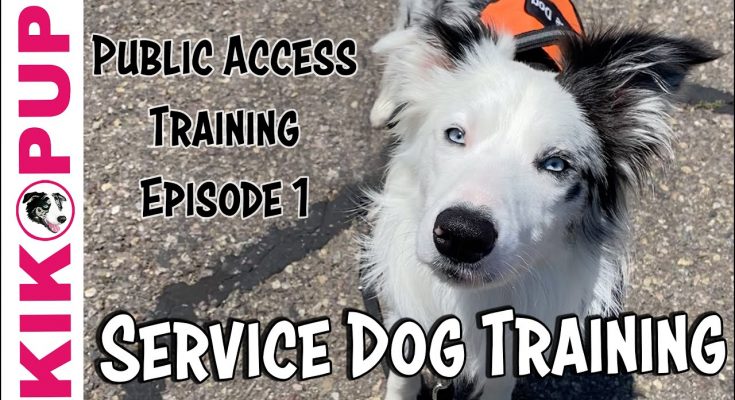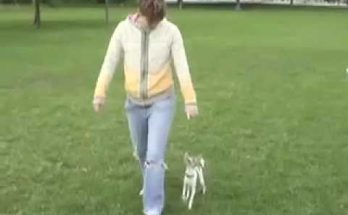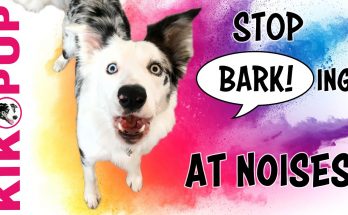This is the first video in a series of videos of training service dogs for public access. This video is for service dog teams working on teaching their dog to be calm, confident, reliable and safe in public spaces where dogs are allowed as well as where only service dogs are allowed. However, these tutorials and tips are great for everyone who wants a confident, well-behaved dog to bring places that pet dogs are allowed to go in public. In no way does this video condone training a fake service dog to bring places pet dogs are not allowed. Instead, if you have a pet dog, the goal of this training is to be able to go places like parks, boardwalks, city streets, outdoor dog friendly cafes and restaurants and stores that do not sell food and have a policy where pet dogs are allowed to enter. Yes, Halo is my service dog, replacing Splash my 13 year old. I don’t usually like to talk about it publicly as it is a sensitive issue for me, however at this point in my life, I believe I can help so many people who rely on their service dogs as well as help service dogs feel more comfortable and confident in their everyday lives that I figured showing my personal training with Halo my new service dog was important.
The topics covered in this episode are: Teaching your dog a calm greeting behavior, teaching your dog to be confident with unexpected and unwanted attention from humans, teaching your dog to wait patiently to get out of the vehicle and into the vehicle, as well as to teach your dog to wait calmly with you before you move away from your vehicle. This video also briefly shows how you can use teaching a dog to stop on a default next to you when you stop to teach a dog to go up and down stairs without rushing ahead of you.
The tutorials I mention in this video are:
Teaching the “touch” cue where the dog touches an outstretched hand:
Teaching a dog to be comfortable with grooming and handling:
Service dog playlist: https://www.youtube.com/watch?v=_yKG2Ht1FlA&list=PLXtcKXk-QWogf3XIaspGvZcHlXuS8rs9Z
****If you have a dog who can become fearful, shy, reactive or aggressive, you must seek help from a professional trainer who uses Positive Reinforcement to help you with these exercises as you might not be able to read your dog or know how or when to increase or decrease criteria and the training could go backward instead of progress.****
Here are the times that the different tips and tutorials appear in this video:
00:00 Introduction and explanation of the training of teaching a calm greeting as a behavior and preparing to teach your dog about surprise encounters with humans
15:18 Video footage of training the exercise of a calm greeting on cue
19:50 Explanation of training for surprise encounters with humans when in public
22:53 Video footage of working on the exercise of surprise encounters with people who try to interact or touch your dog without asking
25:26 Explanation of training your dog to wait until cued, when exiting and entering a vehicle as well as waiting on a loose leash with you after exiting the vehicle.
26:20 Video example of waiting for a verbal cue to get out of a vehicle
27:00 Video example of waiting for a verbal cue to get into the vehicle
27:17 Explanation of teaching your dog to wait with you on a loose leash after exiting a vehicle
29:11 Video examples of training your dog to wait with you on a loose leash after exiting the car
30:46 Video footage example of how the default stop when you stop exercise can help with teaching your dog to stay with you instead of rush ahead when going up or down stairs
#dogtraining #positivetraining #professionaldogtraining





Oh my goodness yes, this is amazing! Free resources for SD or AD handlers are in scarcity, this is gonna be so helpful for so many handlers. Watching with keen interest as I train my second SD.
Awe thanks! Yeah I really think it will help a lot of dogs and people and organizations can use it as training examples.
Just wanted to say that you inspire me to become a dog trainer, and to work hard with my dog. Thank you for being amazing!!!
You deserve way more subscribers than you have.
Awe thanks! I am happy with the subscribers I have, too many and you receive more personal attacks and bulling so this is a good amount for me, I can help the people that really search for the info.
Exactly what I needed for training my mobility and allgery alert dog! Thank you! Looking forward to seeing every episode of this series!
Oh awesome! Glad the videos can be of help!
I am so glad you are doing this series. My dog freaks out when people approach try to pet her or I try to hand the leash over. This is exactly what I needed to help her. Thank you.
I just got a puppy two weeks ago that I’m going to be owner training for service work, so this comes just in time! Can’t wait for more.
Love how your tutorials all ways put the welfare of the dogs first.
Always breaking the steps into bite size pieces with easy explanations & demonstrations making it much easier to remember and replicate at home regardless of experience.
Thanks to your tutorials I Have a very close bond with my dog. Being a cavalier is naturally esspesally welcoming of fuss & pamper.
Very much Looking forward to this series. So very excited indeed.
Absolutely loving your channel & all what you do. Thank you so much.
Awe yes Cavaliers are often so sweet and charming and hard to resist!
This video is really amazing! The very idea of training a proper, safe, and confident way of greeting people and getting accustomed to being petted is fantastic. Thanks Emily! 🙂
I love this video! Thank you for making this! 🙏🏼 I can’t wait for more of the series
Thank you for including the disclaimer discouraging people from using this training information to help them bring pets and ESAs where they don’t need to go!
I’ll put it in every video 🙂
This, AND thank you all in the service partner community for sharing resources, despite misuse by some. I’m in the pre-training for service part of raising my service dog and I’m reading and watching a lot to learn what to expect and begin to help my pup avoid unwanted behaviors before they’re habits.
Thank you! I don’t have a service dog but my dog is nervous meeting new people that just come up to pet him, I would love to give him the option to greet people on his own accord, so we will definitely be practicing this!
Now if we could only train the people 😆
Great video Emily. And as usual, I expect to see and hear exactly what you’re explaining. My SD Mason, is approaching retirement and I’m in the process of getting his replacement ready to take over. At times I feel sad that his duties are coming to an end because he really loves his job. I feel also blessed I’ve had him by my side for the past 10 years and he’s almost 12. The new one is a McNab and I chose this particular breed for their desire to work and not be as soft as my border collie, people don’t recognize the breed as quickly as the border thus giving me space needed without them asking to pat him etc. I am looking forward to watching your series on this important topic. Your caring and sharing is beyond a beautiful gift to others. I really can’t see how other trainers or non are anything but thankful there are people such as yourself who keep it about the dog. Thanks Emily
Awe I am sure Mason will find some jobs to do for you when you are home together in his retirement. Congrats on your McNab!
thank you for taking the time to do this, it’s stuff i haven’t considered before! it’ll definitely reduce my anxiety in public spaces to have a plan! also i realized my trainer started introducing this idea of ignoring/being proofed to unexpected touching when she introduced a stand command (he plants his feet and holds his position). i should have worked on that more since she introduced it, but i’ll be seeing them again soon !
Oh yeah, handling is always good to go back and do brush up training 🙂
Would love to hear more of your input about dealing with other people while training a SD! It’s one of my biggest stressors when it comes to dog training in general.
Hearing horror stories from SD handlers will help me prepare my dog for those situations, but I really wish somebody would train ME for them!
This series is so extremely helpful. My future service dog is likely to be a Japanese Akita, and they can be known to be a bit wary of strange people. It’s good to hear these tips to prepare for desensitizing him to random people trying to pet/make noises at him
Im in the process of training my pup to assist me with diabetes and anxiety, and this was really helpful, thank you. She’s a bit skiddish because she wasn’t raised properly before I got her, but she’s still so sweet. so it’s gonna be a long process, but this series will help immensely. Thank you 🙂
Thank you for this!!! My dog can’t alert me to seizures but I want to train him to get help in case we’re in public and I have a seizure when I’m alone. I can’t have an official alert dog because I already have two dogs and 3 would be too much for me. This series might save my life!!
Dogs can learn to alert to oncoming seizures.They are excellent at it. Anything to do with scenting usually comes pretty easily to them
Thank you so so much for these videos! My spouse has Multiple Sclerosis and had a service dog that died unexpectedly as a result of a veterinary surgery a few months ago. I adopted a golden puppy and I am so glad I found this! He is doing so well with his training and last week was his first public access and I was amazed at how well he did! Your videos are phenomenal!
I am currently training my Rottweiler at home and this series has helped us so much. My Luna came from a shelter and is a year and a half, but she’s been very tuned in to my anxiety since we adopted her 2 months ago. She’s already picked up on a few of my nervous habits and has already learned to distract me and redirect my attention with surprising consistency. Her focus out in public is our little hurdle atm but she is coming along nicely thanks to you!
Service Rotties for the win!!!
Thank you for these episodes.
Other dog trainers asked if my last dog (male West Siberian Laika) was trained as a seeing-eye dog, and always said no. He was just heavily socialized in Helsinki and was indifferent to other dogs and strangers. And was regarded as well-balanced and even temperament by the show-judges despite being imported from a hunting cooperative in Lake Baikal region.
So, that’s why I want to try training formally with this dog,
I’ve read accounts of Evenki individuals using their dogs for assisting with disabilities.
I am aware of the caveat though with WSL: S.V. Bogatov wrote dogs bred for commercial hunting tend to be level-headed, calm, quieter, settles well and more social compared to dogs bred for recreational hunting.
Pavel’s parents came from industrial lines in East Siberia, while Zarya comes from recreational lines in Europe.
Thank you so much for this series! I am still working on training with my Border-Aussie for public outings so we can take the Access test. I’ve had a very hard time finding any service dog oriented trainers near us to work with though. I was a little nervous about training my own dog, because it seems more looked down on, but this has made me feel much more confident in what we have accomplished and need yo work on. Thank you!!
Yes it’s hard to find a trainer who uses positive methods